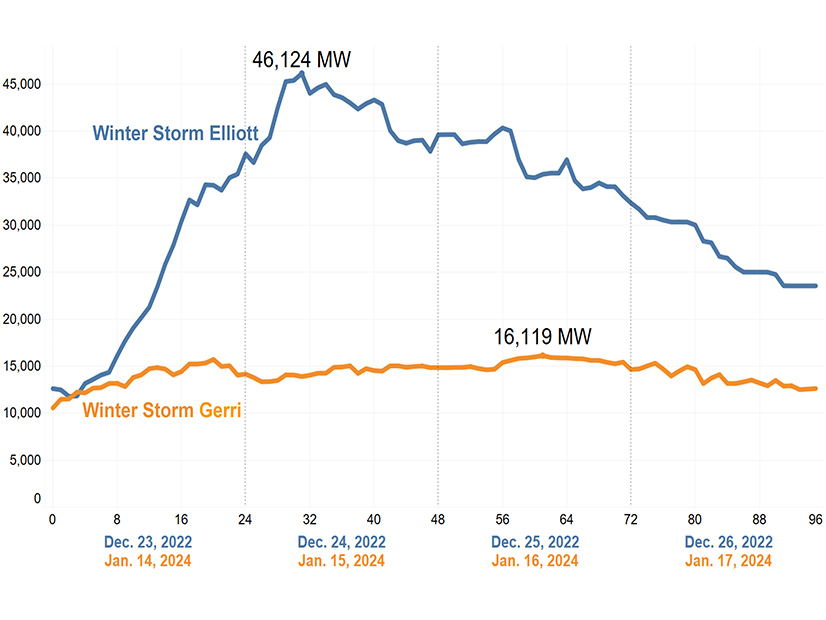
PJM last week said the grid maintained reliability through nearly a week of harsh winter conditions during the winter storm that blanketed much of the nation during mid-January.
Dave Souder, PJM executive director of system operations, told the Jan. 24 meeting of the Markets and Reliability Committee that the grid was at its most strained Jan. 17, which saw a peak load of 134,777 MW and some emergency procedures implemented to mitigate transmission constraints. Cold weather alerts were in place from Jan. 14-17 and Jan. 19-22.
Comparisons to December 2022’s Winter Storm Elliott dominated the discussion, with PJM making the case that several market and operational improvements bolstered performance. Souder said the RTO drew on its experience with generation performance during cold weather to take more action before the storm arrived. Dispatchers manually committed thousands of additional megawatts through the day-ahead market to give long-lead units time to come online and combustion turbines that have had trouble procuring gas in the past additional notice to firm up their fuel.
Conservative operations were in place between Jan. 13 and 17 to provide dispatchers with greater flexibility to keep long-lead resources online when they’d otherwise be released on economics.
“We took a risk-based unit commitment approach,” Souder said.
PJM’s Brian Chmielewski said transmission congestion also peaked on Jan. 17, with 19 constraints reaching the $2,000/MWh transmission constraint penalty factor (TCPF). Heavy load interchange and congestion drove system marginal prices to the $500/MWh range Jan. 17 and 18.
Vitol Vice President of Regulatory Affairs Jason Barker questioned if price spikes on the mornings of Jan. 16, 17 and 18 were driven by PJM load or exports to neighboring regions, saying that the timing appears to align with the MISO morning peak. PJM representatives were unable to confirm the observation, but agreed to examine event data.
Souder said additional information will be presented at next month’s Market Implementation and Operating committee meetings, scheduled for Feb. 7 and 8, respectively.
The rate of generation outages was around a third of the peak during Elliott at 16,119 MW offline Jan. 16 versus 46,124 MW on forced outage Dec. 24, 2022. Souder said the gas fleet’s performance in particular was much stronger this month; though pipeline capacity restrictions were in place throughout the storm, there were few compressor station or gas well failures, and pipeline operators coordinated with PJM to improve forecasting.
Generators that did experience disruptions impacting their output also made use of PJM’s newly implemented temporary exception process to report their diminished output. One of the challenges PJM highlighted following Elliott was a significant number of generators not reporting issues to the RTO until dispatchers attempted to bring them online.
Independent Market Monitor Joe Bowring told RTO Insider that PJM took a “very conservative” approach to the storm and relied on a forecast that turned out to be much more accurate than that for Elliott. While he applauded the performance of PJM operators in keeping the grid online through their actions, he said that a stronger market design would commit generators based on economics.
“The operators made the system work, and we’re happy they did, but when we think of the bigger picture, markets were not relied on,” he said.
He argued that the need to manually commit resources during the storm highlighted the need for ongoing stakeholder discussions over the reserve market design to focus on how to include market parameters that reflect a need for short-term reserves. He contrasted the need for reserves that can operate through a storm lasting a few days to the decision to increase the synchronized reserve requirement by 30% last May. (See “Stakeholders Reject PJM Synch Reserve Manual Change; RTO Overrides,” PJM MRC/MC Briefs: May 31, 2023.)
“You don’t need more reserves year-round; you needed them for a couple days last week,” he said.
Several stakeholders questioned the cost of $28 million in uplift payments to generators committed under conservative operations, arguing that costs should be built into the market, while others said the current market structure provides dispatchers with flexibility to commit units as they may be needed in real time.
Gregory Poulos, executive director of the Consumer Advocates of the PJM States (CAPS), said that both uplift payments and exports during strained conditions are worrying, but in this instance PJM’s actions appear to be warranted because of the concern that generators wouldn’t be able to perform during a holiday weekend winter storm — the same scenario PJM found itself in during Elliott. In this case, the holiday was Martin Luther King Jr. Day, instead of Christmas in 2022.
The storm brought a new record-high peak load of 34,524 MW in the Tennessee Valley Authority region Jan. 17, and other PJM neighbors also saw high loads, leading the RTO to export 12,131 MW, the equivalent of nearly 10% of its own load.
Gregory Carmean, executive director of the Organization of PJM States Inc. (OPSI), questioned whether the large amount of exports signal that other regions are leaning on the RTO for reliability at the same time that it has been recommending reducing projected reliability benefit of imports reflected in the capacity benefit of ties (CBOT) value. The package of market changes PJM proposed in the Critical Issue Fast Path process last year would have set the CBOT to zero, but the Board of Managers did not include that component in its proposal now pending before FERC. (See PJM Board Releases Outline of Capacity Market Changes.)
Noting that the drop in temperatures was most severe in the ComEd zone, AEP Energy Director of RTO Operations Brock Ondayko said more detailed analysis on generation outages by zone could provide more information about any incremental improvements made in generator performance in subzero temperatures.

